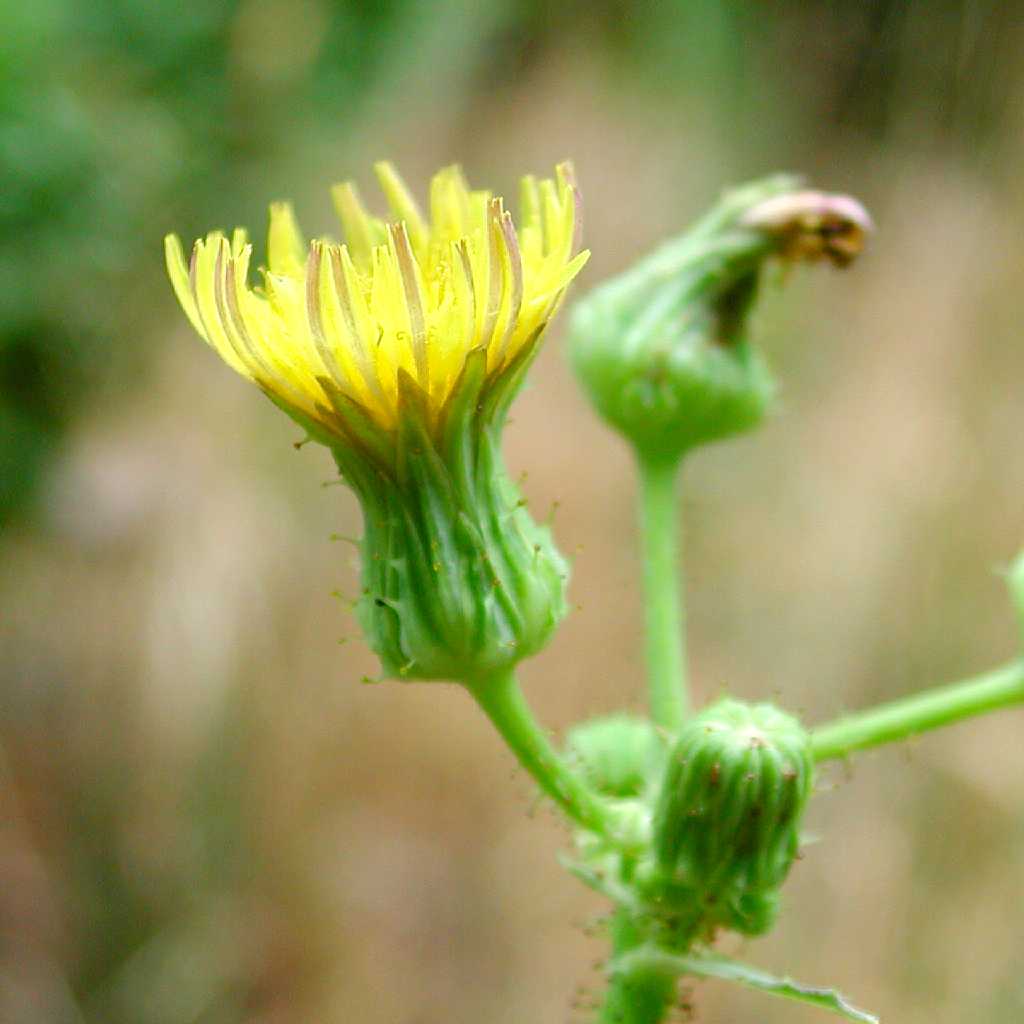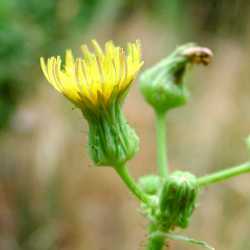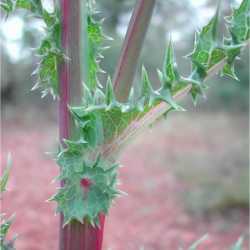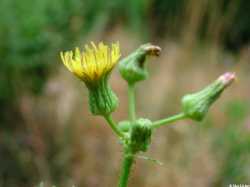Annuals or biennials, 10-120(-200+) cm. Stem bases soft, herbaceous, hollow. Leaves: blades of mid cauline spatulate or oblong to obovate or lanceolate, 6-30 × 1-15 cm, bases auriculate, auricles often recurved or curled, rounded, margins often pinnately lobed, lobes ± deltate (not constricted at bases), terminals usually larger than laterals, usually prickly-dentate. Peduncles usually stipitate-glandular, sometimes glabrous. Involucres 9-13+ mm. Phyllaries usually stipitate-glandular. Corollas: ligules mostly shorter than tubes. Cypselae stramineous to reddish brown, mostly ellipsoid, strongly compressed, ± winged, 2-3 mm, ribs 3(-5) on each face, faces smooth across and between ribs; pappi 6-9 mm. 2n = 18.
Flowering (Mar-)Jul-Nov (year-round in south). Disturbed sites, roadsides, along streams; 0-2500+ m; introduced; St. Pierre and Miquelon; Alta., B.C., Man., N.B., Nfld. and Labr., N.S., Ont., P.E.I., Que., Sask., Yukon; Ala., Alaska, Ariz., Ark., Calif., Colo., Conn., Del., D.C., Fla., Ga., Idaho, Ill., Ind., Iowa, Kans., Ky., La., Maine, Md., Mass., Mich., Minn., Miss., Mo., Mont., Nebr., Nev., N.H., N.J., N.Mex., N.Y., N.Dak., Ohio, Okla., Oreg., Pa., R.I., S.C., S.Dak., Tenn., Tex., Utah, Vt., Va., Wash., W.Va., Wis., Wyo.; Europe, w Asia, n Africa; introduced also in Mexico, Central America, West Indies, Bermuda, South America, e Asia, s Africa, Pacific Islands (New Zealand), Australia.
L. Boulos (1973) distinguished subsp. asper (annuals with leaves mostly cauline, cypselae margins little or not at all curved and/or ciliate, and one pair of chromosomes with small satellites) from subsp. glaucescens (biennials with leaves mostly in rosettes, leaves mostly stiffer and more prickly than in subsp. asper, cypselae with curved, ciliate margins, and two pairs of chromosomes with large satellites) and noted that the two subspecies are morphologically rather difficult to distinguish if the specimen in hand lacks the rootstock or stem base.
According to H. N. Barber (1941), crosses between Sonchus asper and S. oleraceus resulted in sterile hybrids.
This is more common than the preceding species [Sonchus asper] and found in similar habitats.
Duration: Annual
Nativity: Non-Native
Lifeform: Forb/Herb
General: Erect, taprooted annual herb, 0.3-2.5 m tall, with milky sap. Herbage glabrous; peduncles and involucres often with tack-shaped, glandular hairs (also called stipitate glands).
Leaves: In basal rosettes and alternate along stems, the basal leaves with petioles often as long as the blades, and stem leaves sessile with auriculate-clasping bases; basal blades oblanceolate to spatulate in outline, to 30 cm long, lyrately or runcinately pinnatifid into broadly ovate to oblong lobes, the margins dentate and sometimes bearing spinulose teeth; stem leaves similar to basal leaves but usually with auriculate bases, the auricles to 2 cm long, rounded and saliently toothed.
Flowers: Flower heads pale yellow and ligulate, terminal on branch tips,on peduncles 10-16 mm long; involucres urceolate-turbinate in bud and campanulate or cylindric in anthesis 10-16 mm high, the bracts (phyllaries) in 3-4 unequal series, the inner phyllaries lance-linear with acute to attenuate tips, glabrous or sparsely glandular-pubescent and the outer phyllaries ovate, glandular, and half the length of the inner phyllaries; florets all ligulate (similar to ray flowers but always bisexual), the ligules (ray petals) 3-6 mm long, pale yellow, quickly withering.
Fruits: Achenes ovoid, 2 mm long, strongly compressed and 3-5 ribbed on each face, with very thin lateral margins; topped with a pappus of tangled hairs 6-10 mm long, which hold several achenes together in cluster.
Ecology: Found along roadsides, fields, and disturbed sites, below 8,000 ft (2438 m); flowers April-August.
Distribution: Native to Africa and Eurasia, introduced elsewhere. Occurs throughout N. America and in every state in the US; south through MEX to S. America.
Notes: An annual thistle with milky sap, often delicate but becoming robust in the right conditions; erect with clasping leaves that have wavy, dentate margins, each tooth terminating with a sharp spine. Told apart from S. oleraceus by the clasping bases of leaves, which are recurved in S. asper and straight in S. oleraceus, and the achenes, which are strongly 3-5 ribbed on each face and thin-margined; while S. oleraceus achenes are striate and strongly wrinkled transversely, not thin-margined. Achene characters are much more reliable for distinguishing the two species than leaf traits.
Ethnobotany: Given to babies as a sedative, and taken as a heart medicine, although some tribes considered this species a poison.
Etymology: Sonchus is the Greek name for thistle, while asper means rough, alluding to the coarsely spiny leaves.
Synonyms: None
Editor: SBuckley 2010, FSCoburn 2015, AHazelton 2015, AHazelton 2017
Much like no. 2 [Sonchus oleraceus L.] commonly more prickly; lvs pinnatifid, or frequently obovate and lobeless, with rounded and conspicuously prickly-toothed, not acute auricles; cor-tube somewhat longer than the ligule; achenes flatter, with 3(4-5) evident ribs on each face, not rugulose, although there may be minute projections from the marginal ribs; 2n=18. A cosmopolitan weed, native to Europe. July-Oct.
Gleason, Henry A. & Cronquist, Arthur J. 1991. Manual of vascular plants of northeastern United States and adjacent Canada. lxxv + 910 pp.
©The New York Botanical Garden. All rights reserved. Used by permission.






